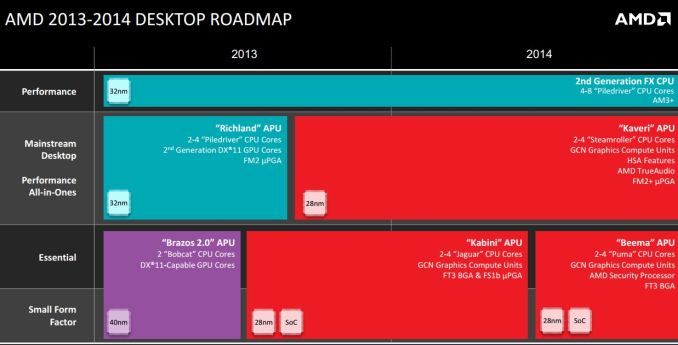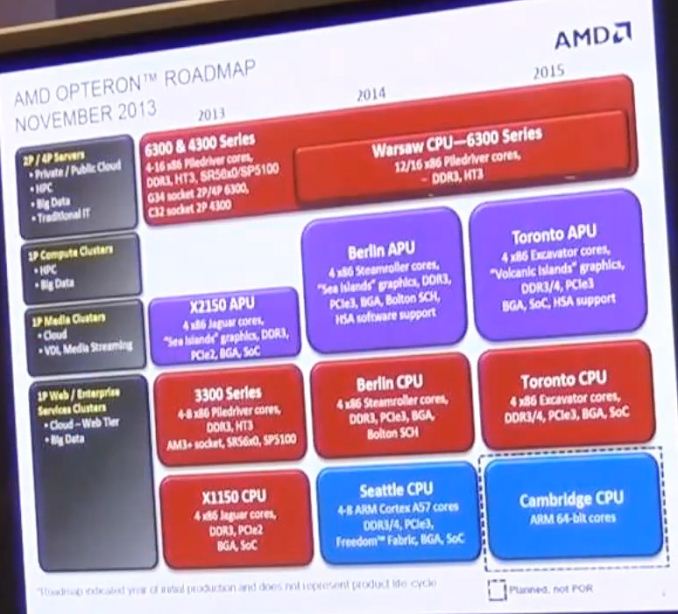AMD Kaveri Review: A8-7600 and A10-7850K Tested
by Ian Cutress & Rahul Garg on January 14, 2014 8:00 AM ESTSocket: FM2+
The new Kaveri processors are built to use the sort-of new FM2+ socket based motherboards. These motherboards fit both FM2+ and FM2 APUs, and thus have been on the market for a good number of months already. However the boards currently on the market may require a BIOS update, and e-tailers shipping motherboards out today may still have the older not-updated revisions in stock, so it is worth confirming that the motherboard you order is updated.
AMD’s generational split on Kaveri is indicative of market pressure and AMD’s history – users like either the processor or the motherboard to be forwards or backwards compatible in terms of compliance. In this case the following table applies:
| Socket Compatibility Chart | ||
| Will Work in FM2 | Will Work in FM2+ | |
| Richland | Yes | Yes |
| Kaveri | No | Yes |
As Kaveri comes with two extra pins that are blocked off with older FM2 motherboards, they are not compatible.
For our testing today, we had sourced the ASRock FM2A88X Extreme6+ and FM2A88X-ITX+ motherboards, both of which will be the focus for review in due course.
Chipset/FCH: A55, A78, A88X
To add some confusion into the mix, AMD is using a mixture of old and new chipsets on FM2+. Kaveri will support the A55, A78 and A88X chipset based motherboards, but not the A75 chipset that was used for Llano/FM1 motherboards. Perhaps more confusing is that while the old Richland APUs will be able to be used on FM2+ with A88X, the older FM2 motherboards will not come with A88X. How about a table to make it clearer:
| Chipset Compatibility Chart | |||
|
Will Work with Llano APUs |
Will Work with Trinity & Richland APUs |
Will Work with Kaveri APUs |
|
| A55 + FM1 | Yes | No | No |
| A55 + FM2 | No | Yes | No |
| A55 + FM2+ | No | Yes | Yes |
| A75 + FM1 | Yes | No | No |
| A75 + FM2 | No | Yes | No |
| A78 + FM2+ | No | Yes | Yes |
| A85X + FM2 | No | Yes | No |
| A88X + FM2+ | No | Yes | Yes |
Though even a table doesn't make the compatibility matrix crystal-clear, it does help to make sense of what users can expect for chipset and sock compatibility. Basically, any A88X motherboard you buy will fit the Kaveri APU. For A78, we are currently under the impression that these will be FM2+ only as well, just do not get confused with older ‘AMD 780L’ Northbridge chipsets that were advertised with A78 in the motherboard name that used the AM3 socket. A55 is almost a free-for-all, with FM1 and FM2 motherboards using it.
As for the differences between the older A85X and A88X chipsets, there are only a few to speak of. Support for PCIe 3.0 is the big one, with any FM2+ and A88X motherboard and Kaveri APU taking full advantage of PCIe 3.0 in all its glory, either as an x16 slot or an x8/x8. A88X still has eight 6 Gbps ports and four USB 3.0 ports native, as well as supporting RAID 0, 1, 5 and 10. The other only upgrade to note is the move to XHCI 1.0.
| Chipset Comparison | |||||
| A55 | A75 | A78 | A85X | A88X | |
| Chipsets |
FM1 FM2 FM2+ |
FM1 FM2 |
FM2+ | FM2 | FM2+ |
| PCIe Generation | 2.0 | 2.0 | 2.0 | 2.0 | 3.0 |
| PCIe Lane Allocation | 1x16 | 1x16 or 2x8 | 1x16 | 1x16 or 2x8 | 1x16 or 2x8 |
| SATA 6/3 Gbps | 0 + 6 | 6 + 0 | 6 + 0 (?) | 8 + 0 | 8 + 0 |
| USB Ports (3/2/1.1) | 0 + 14 + 2 | 4 + 10 + 2 | 4 + 10 + 2 (?) | 4 + 10 + 2 | 4 + 10 + 2 |
| RAID | 0, 1, 10 | 0. 1, 5, 10 | 0. 1, 5, 10 | 0. 1, 5, 10 | 0. 1, 5, 10 |
| TDP | 7.6 W | 7.8 W | 7.8 W ? | 7.8 W | 7.8 W ? |
Unusually for AMD, little information about chipset evolution was provided through the normal channels.
What about FX CPUs, or Server CPUs?
Leaked roadmaps have not been kind to AMD’s FX range. The ‘king’ of the Vishera family of FX CPUs, the quad-module eight-thread FX-9590, looks like it will be the king of the FX line for a little while longer, as shown in this roadmap:
As you might imagine, there is no public comment from AMD about the lack of new FX CPUs with Steamroller cores coming soon.
Depending on which roadmap you look at, AMD’s server offerings are mixed. Some report that During 2014 we will see the launch of “Warsaw” CPUs featuring 12-16 Piledriver cores, and there is no current mention of high-end Steamroller based Opterons at all. The official roadmap from AMD from June shows this, including their ARM server discussion, but a recently leaked roadmap shows that Steamroller will appear in their 1P compute clusters, followed by Excavator in 2015, but Piledriver based 12-16 thread machines will stay at the top of the pile.













380 Comments
View All Comments
Nagorak - Wednesday, January 15, 2014 - link
The fact is these "APUs" are really pretty worthless. If you're going to be seriously gaming then you want to get a discrete graphics card, even a low end one. The problem with AMD's strategy here is that the integrated GPU performance is still so anemic that it's only useful for people who want a budget PC and who don't actually play games. Therefore the "benefits" of having both CPU and GPU on one core are highly questionable.ImSpartacus - Thursday, January 16, 2014 - link
That could be solved if we had a much larger GPU on the APU, right?I want to see at least 12 CUs on the top-end APU, preferably more like 16-20 CUs.
lmcd - Monday, January 20, 2014 - link
Did you miss the whole conversation about memory bandwidth?nader_21007 - Saturday, January 18, 2014 - link
below the charts showing the games performanc, there are two tabs, one for showing avarage frame rate and the other, if you just click on it will show you the suddeframe rates for the apus compared. Minimum frame rate of the iris pro is the lowest and worst among all Apu's compared. It means sudden hangings all over the game. Kaveri and other amd apu's have no such weaknesses because of high performing IGP.Now tell me which is Outperformed?themeinme75 - Saturday, January 18, 2014 - link
the good news is APU-7850/SOC-5200pro just caught up to 4850..cryptik - Monday, March 30, 2015 - link
The R7 consistently beats the Iris Pro. You must have read a different article than everyone else.frozentundra123456 - Tuesday, January 14, 2014 - link
Good review, except he doesn't really address the elephant in the room that even for gaming, a low end cpu like the athlon X4 with a HD7750 will be considerably faster than any APU. So in this regard, I disagree with the conclusions that for low end gaming kaveri is the best solution. It is disappointing actually, that he did not use a HD7750 GDDR5 as the discrete gpu comparison, because that would have given a more direct comparison of how the bandwidth restrictions are affecting Kaveri.I will say though that the low TDP parts seem to get a nice improvement in performance. They actually seem more attractive that the high end, since there is little gaming improvement in the top end vs Richland.
thevoiceofreason - Tuesday, January 14, 2014 - link
Or something like Pentium G2120 (90$ newegg) and HD7770 (90$ ASUS or MSI on newegg after rebate). The difference between such a setup and a top of the line kaveri chip is not even funny. Kind of tragic, really.andrewaggb - Tuesday, January 14, 2014 - link
I agree. I am extremely dissappointed. Cpu performance and GPU performance barely changed from last year's model. HSA is definitely the future, and Mantle may deliver a healthy fps improvement, but I feel like this product has almost no value at launch. It's all depending on future software.I was actually considering a kaveri for a kids pc... but I'm definitely way better off getting an intel cpu and amd gpu.
andrewaggb - Tuesday, January 14, 2014 - link
I guess they did make big gains on TDP. So it's sorta their version of a haswell refresh. But haswell had a larger improvement in both cpu and gpu performance relative to their previous chip.